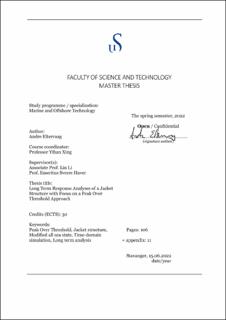| dc.description.abstract | This thesis investigates the use of long term analysis to estimate the q-probability responses of a non-linear problem. The structure subjected to the investigations is a realistic jacket found in the Norwegian Continental Shelf (NCS) with slightly increased deck mass to increase the dynamic behaviour. The following responses are investigated, airgap, deck displacement, overturning moment and base shear. The long term analysis q-probability responses are obtained using the peak over threshold (POT) method and a modified all sea state approach. Hindcast data from a reference site in the Norwegian Sea is used with over 61 years of metocean data.
The responses from the jacket structure follow a Gumbel distribution. Therefore, the maximum response for each 3-hour simulation is obtained, and Gumbel´s location and shape parameters are assessed for each sea state by method of moments. The unknown sea states between the simulated sea states are known by an interpolation function named spline. As a result, a response surface is obtained as the short term variability for the 3-hour maximum responses.
The modified all sea state method uses the joint distribution of all 3-hour sea states over 8 metres (m). The probability density of the joint distribution of sea states is multiplied by the short term response surfaces to obtain the long term distribution of a 3-hour maximum response. The q-probability values correspond to a 100-year and 10.000-year response value.
The POT approach is implemented as the long term distribution of a response given the most probable maximum response for a random storm. Each storm is sequenced by 3-hour storm steps which are assumed stationary. The long term analysis is achieved by multiplying the conditional distribution of storm maximum response given the most probable maximum response with the long term distribution of most probable maximum responses. The q-probability is the same as for modified all sea state.
The long term analysis results demonstrate that for a jacket structure, the q-probability responses are less conservatively estimated by the POT. This implies that for design work, the responses obtained by the POT following the guidelines for q-probability will have a better cost-optimized design without disregarding or compromising the safety. | |
